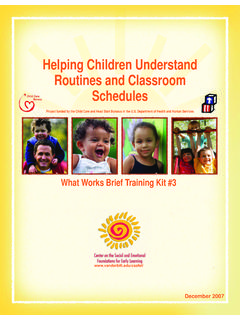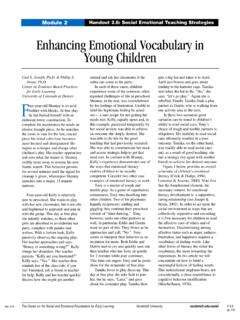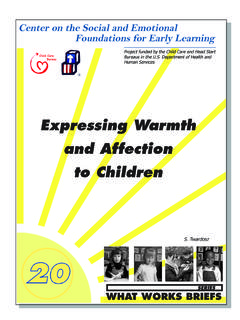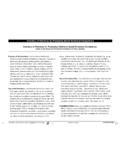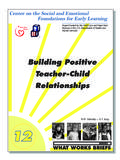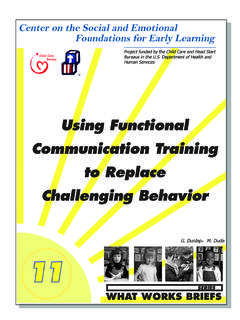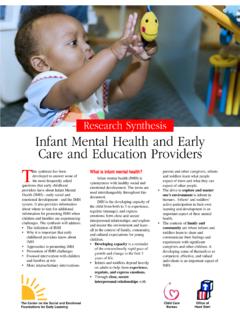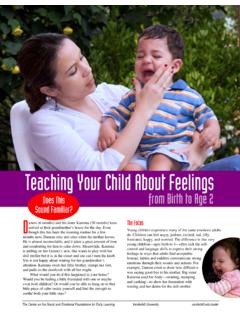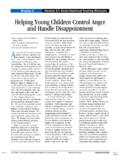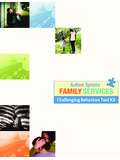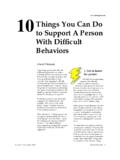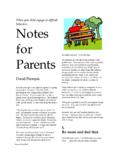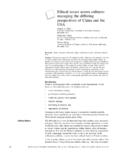Transcription of Acknowledging Children’s Positive Behaviors
1 Acknowledging children sPositive Behaviors22 What Works Brief Series Matt Timm and Sharon DoubetCenter on the Social and Emotional Foundations for Early LearningProject funded by the Child Care and Head Start Bureaus in the Department of Health and Human ServicesAcknowledging children s Positive BehaviorsKathy was frustrated with how thingswere going in her classroom whereshe is the teacher of 3- and 4-year-old children . Several children were havingdifficulties with transitions. They wanderedaround the room, became easily agitated,and disrupted the whole class. Although Kathy had beenteaching for 5 years, she was beginning to doubt her abilitiesas the right teacher for this group of children . Kathy talkedabout her challenges with Hank, the director of the suggested that he videotape the class so that theycould later watch the tape together and look more carefullyat what was happening during transition times. Kathyagreed to have her class videotaped because she trusted that Hank would be supportive and his feedback would be constructive rather than critical.
2 A week later, Kathy and Hank watched the videotape andfocused on the transition between center-time and had suggested that they keep track of what Kathysaid to the children and their responses. As they watchedthe tape, Kathy was surprised to hear her loud tone and to see her increasingly aggravated body language ( ,tense, standing above the children , hands on hips). Shenoted how many times she heard herself say, Stop that!What are you supposed to be doing? This room needs tobe quiet. We are out of time. The chaotic atmospherein the room seemed to increase as Kathy s aggravation increased. Hank recommended that they work together to use a strategy to reduce inappropriate Behaviors by focusing on children s Positive Behaviors . He gave Kathysome materials to read on Acknowledging young children spositive Positive Behaviors : How DoesThis Strategy Work? Acknowledging Positive Behaviors is a strategy that educa-tors, family members, and other caregivers can use to devote more time and attention to desirable child behaviorthan to undesirable child behavior .
3 This strategy is basedon four key findings from research involving young children and their supportive adults: Most child behavior is strengthened or weakened by what happens after the behavior occurs. For example, a toddler who receives laughter and applause for mak-ing a funny face is likely to keep making funny faces. Often adult attention is captured by child misbehavior; teachers and parents can be, in a sense, hypnotized by a child s misbehavior, seemingly unable to attend to appropriate behavior by other children . Attention from primary caregivers is so important to young children that they will continue a behavior thatproduces negative reactions. The result can be an increase in the very behavior that adults wish to discourage. For example, think about a child who con-tinues to run toward the classroom door over and overagain as the teacher shouts, Don t make me come overthere; you know not to leave the classroom! That kindof attention will reinforce and increase that behavior .
4 Although a specific child behavior may be temporarily weakened by a negative response from the adult, thereis no assurance that a more desirable behavior is beingidentified and encouraged in the process. For example,telling a child that she cannot go outside to play because she dumped her toys all over the floor does not teach the child how to put toys away. The more desirable behavior needs to be taught. How Can Teachers Use the Strategy of Acknowledging Positive Behaviors ?Give Positive responses to the desired behavior andavoid responding when that behavior is not approach requires that adults give Positive responsesto desired child behavior and do their best to avoid responding when that behavior is not occurring, unlesssafety issues arise. Positive responses involve communicat-ing verbally and nonverbally with the child but also caninclude presenting favorite objects (toys or books), pictures, sounds, or other items. Kathy was worried that ifshe ignored inappropriate behavior the children mightend up completely out of control.
5 Hank listened to her concerns and told her about some of the problems that heran into when he started Acknowledging children s positivebehaviors in a classroom setting. Hank told Kathy that behavior sometimes gets worse before it gets better whenyou withdraw attention and reward (the response extinc-tion pattern). However, if you start rewarding Positive Behaviors , you should see an initial improvement, followedby some variability ( , good days, bad days), followed bymore consistently good days. Hank said that he wouldhelp Kathy make plans for handling unsafe behavior andthat he would work very closely with her once they actuallystarted using this the number of times the Behaviors planned approach requires that adults record the num-ber of times certain child and adult Behaviors occur. Hankhelped Kathy get started by developing a simple form withthree columns. The columns were titled: (1) What happensbefore the behavior ? (2) What is the problem behavior ?
6 And (3) What do the adults/child do after the behavior ?Hank was encouraging and worked with Kathy on record-ing the information about the behavior . Kathy began tofeel better when she could see the pattern and relationshipbetween child and adult Behaviors . For example, she noticed that when she commented on one child s attentiveIssue 22 July 2007 Page 2behavior to a peer who was sharing a story with the largegroup, other children began to sit up and pay attentionalso. Being able to step out of the classroom action andlook at the information gathered helped Kathy analyzewhat was happening in her a plan to meet your individual needs. The next step is for adults to develop a classroom advised Kathy that it is a good idea to initially selectone desirable behavior and a just few children . After every-one has experienced some success, she could then move toa more challenging behavior . Kathy decided to start withcleaning up toys when center-time was over.
7 Hank thenasked Kathy to work on definingthe behavior that she wanted tosee increase; to consider where,when, and how often she wouldbe looking for that behavior ;and to think of situations thatmight increase the likelihoodthat children would engage inthat behavior . At their next meeting, Kathy andHank developed a list of expecta-tions for picking up toys and plans for teaching the childrenthe expectations. Together they developed a list of positiveresponses to use in the classroom. They decided to keep theresponses simple and descriptive Thank you for puttingthe truck on the shelf and to make sure that they includednonverbal responses (like smiles, winks, thumbs-up). Theyagreed on the importance of not responding to the children sunacceptable behavior unless someone was in immediatedanger. Even then, Kathy would do her best to act quicklywith minimum interaction. Hank helped Kathy by roleplaying a few situations during which she would respondto appropriate behavior by using Positive , descriptivestatements.
8 They reviewed the simple counting sheet that Kathy wouldstart using in the classroom. They decided to target threechildren and record how they were doing with picking uptoys, how many times they received Positive reactions for desired Behaviors , and how many times they received atten-tion for undesirable Behaviors . Kathy felt good knowing thatshe had a plan to address the difficult behavior and thatHank was supportive of her Resources Are Needed? The initial involvement of an experienced person ( , acolleague, supervisor, team member) from outside theclassroom to assist in training and intervention monitor-ing is strongly recommended. Who Are the children Who Benefit? Acknowledging Positive Behaviors has been used with a wide variety of children from 2 years of age to preado-lescence, including children who are typically developingand children described as having conduct disorders,emotional disturbance, communication disorders,autism, and mental retardation.
9 This strategy has beenused effectively by teachers from a wide range of racial,ethnic, income, and educational Behavioral Changes Can Be Expected? Acknowledging Positive Behaviors has been used to helpincrease and maintain a number of child Behaviors including Positive interactions with peers, followingadult instructions, appropriate communication, and independent self-care skills ( , dressing, toileting). Using this strategy results indecreases in aggressive and destructive Behaviors , failureto follow instructions, and inappropriate of this strategy by caregiversresults in adults becoming purposeful in providing posi-tive responses to appropriatechild behavior , monitoringchild behavior more closely,and responding to child behavior more adult reactions to inappropriate child behavior ,less reliance on punishment, and decreased levels ofstress within the classroom also have been strategy is especially well-suited to increasingly informal use across Behaviors , settings, and activities asadults become more familiar with the next day, Hank stopped by Kathy s classroom after thechildren had gone home.
10 Kathy s enthusiasm for her newapproach to behavior was dampened by the children s initial response. She told Hank that when she said some-thing Positive to the children during clean-up time theyseemed shocked. It was as if they were confused when Idid not use a frustrated tone and scolding words. Hankreminded Kathy that behavior changes take time for bothadults and Behaviors did not improve overnight. Some childrenresponded quickly to the descriptive praise and acknowl-edgment, while others continued to run around the roomduring clean-up time. Hank planned to give Kathy someextra hands during the first week of implementing hernew strategy. She needed time to teach the expectationsand for the children to become comfortable with thechanges. In a few weeks, even parents were commentingon how Kathy and the children seemed less stressed andmore like a team working together in the room. Kathycontinued to chart her Behaviors and the children s Behaviors , and felt increasingly competent in her role as a teacher with a plan to acknowledge Positive behavior to decrease inappropriate behavior .
